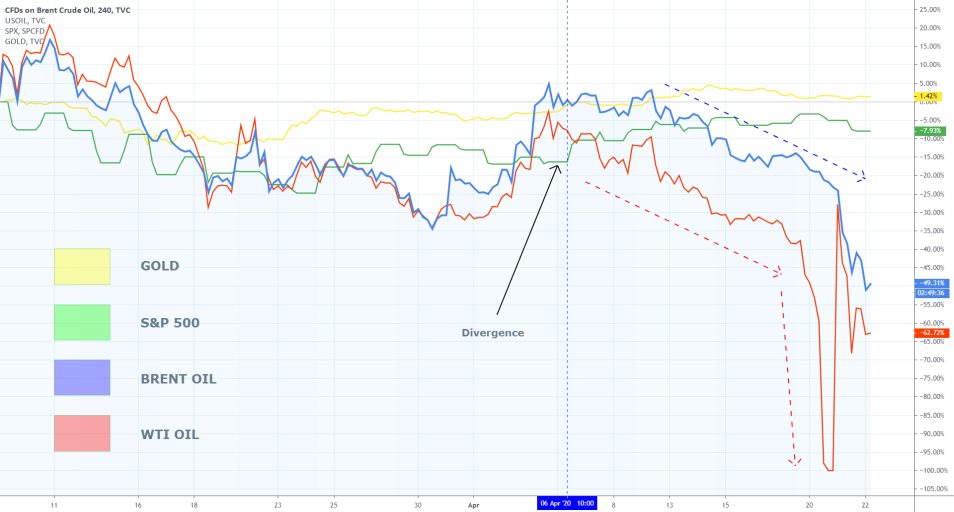
In a remarkable turn of events, the price of WTI (West Texas Intermediate) crude oil tumbled to the unprecedented -$38 per barrel on Monday evening, which triggered a cascade of ripples in the energy market.
The turmoil was the result of many contributing factors spanning several weeks prior, such as the gradual closing downs of economies worldwide resulting in a marked drop in global demand, as well as the commencement of the oil price war nearly two months ago.
More recently, the announcement that the supply storage facilities worldwide were almost fully used up in addition to the WTI May futures contract expiring yesterday prompted additional volatility outbursts, as the nearing of the contract's settlement date saw a sizable rise in trading activity.
Ultimately, the crashing market is the result of uncurbed oil production that is consistent with the pre-pandemic global demand. However, the market currently finds itself in a position where global supply hastily outpaces the greatly subdued global demand, resulting in a massive disequilibrium in the market.
Part of the problem is the recently agreed-upon production cuts of OPEC+'s member states are going to start being implemented from early May onwards, and many market experts fear that these late cuts in production are not going to be substantial enough to breach the gap between supply and demand.
Investors fear that OPEC+'s decisions from early April may turn out to be too little, too late, which underpins the general fears that the current shock in the market might be here to stay.
In the wake of these tremors from late Monday evening, the price of WTI crude oil seesawed drastically between negative levels and just above the $0 threshold, on the aforementioned storage woes. The uncertainty in the energy market dragged the price of the other major benchmark – Brent crude oil – down as well.
UKOIL is currently trading around $17.50 per barrel, but what is more noteworthy is the fact that the crash prompted a divergence (seen on the chart below) between the two benchmarks and the way their prices advance compared to each other.
The price of UKOIL fell drastically as well; however, USOIL came crashing down much more noticeably, which underlines the different magnitudes of concerns that the swiftly depleting storage capacities represent for the two separate benchmarks.
For the time being, Brent oil seems to be demonstrating more resilience to the issue at hand compared to WTI, which could have lasting implications for the demand pressures between the two.

Trendsharks Premium
Gold is undergoing a correction, as investors take profits to offset losses from falling stock prices, impacting their margins. However, we anticipate a renewed wave of [...]
The Swiss stock market index is mirroring its global counterparts, such as Germany 40 and US100, experiencing a sharp decline following the announcement of new [...]
We’re analyzing the weekly chart to grasp the broader market trend. Over the past three years, the US30 index has surged by 17,000 points, often resembling a nearly straight [...]
Over the past week, the DAX has experienced a sharp decline, plunging by an astonishing 3,400 points. This downward movement is not isolated, as its international counterparts, such as the UK100 and US100, are also facing significant [...]
EURUSD recently formed a double top at 1.0930, signaling a potential trend reversal, and has since begun a correction. After a 600-pip rally since early March, a pullback at this stage is both expected and healthy. Given these conditions, we are placing a [...]
Since early March, EURJPY has surged nearly 1,000 pips, providing us with several excellent trading opportunities. However, as the rally matures, many early buyers are beginning to take profits, leading to a noticeable slowdown in the uptrend. On Friday, the pair formed a [...]
The AUDJPY currency pair continues to be dominated by bullish momentum, as multiple golden cross patterns reaffirm the strength of the ongoing uptrend. Despite this, we are witnessing a much-needed [...]
The EURAUD currency pair appears to be undergoing a trend reversal, signaling a potential shift in market direction. A notable technical development is the formation of a Death Cross on the chart, a widely recognized bearish indicator that typically suggests a [...]
After securing an impressive 200-pip profit last week, the EURJPY currency pair is now undergoing a southward correction, retracing some of its recent gains. Despite this temporary pullback, the Golden Cross remains intact, reinforcing our view that the overall trend continues to be [...]
The appearance of a Golden Cross in Silver strengthens our analysis that the metal is currently in a strong uptrend, indicating further bullish momentum in the market. This technical pattern, where the short-term moving average crosses above the [...]
This trade presents a considerable level of risk and can be classified as an opportunistic move based on recent price action. The GBPUSD currency pair has experienced a substantial bullish rally, surging by nearly 500 pips in a strong upward movement. However, after this extended period of appreciation, the pair is showing signs of a potential [...]
The anticipated Death Cross on the SMI20 appears to be failing as price finds strong support at the 23% Fibonacci retracement level. After testing this area, the index has shown bullish strength, printing several large green candles, signaling an increase in [...]
A Golden Cross has just appeared on the USDJPY chart, signaling a potential bullish move. This technical pattern occurs when the 20 period moving average crosses above the 60 period moving average, a widely recognized indication of increasing [...]
After 2 months of a down trend, we finally see some indications of price recovery for Oil. The golden cross, a historic buy signal, supports this [...]
For the past month, the German DAX40 has experienced a remarkable 10% surge, reflecting strong bullish momentum. Despite ongoing market volatility and frequent pullbacks, every dip continues to attract fresh buyers, reinforcing the [...]
Oil continues its downward trajectory, despite occasional pullbacks. The overall trend remains bearish, reinforced by multiple Death Cross patterns, a classic sell signal indicating further weakness. Adding to this bearish outlook, the critical [...]
Over the past few days, gold has experienced a sharp decline of more than $100. This downturn can be attributed in part to traders securing profits to manage their margins, which are under strain due to the significant drop in major indices. Currently, gold has fallen below the [...]
The NASDAQ 100 index is showing strong bullish momentum, as evidenced by the formation of a Golden Cross on the chart. This classic buy signal occurs when the short moving average crosses above the long term moving average, suggesting that upward momentum is [...]
The EURAUD currency pair has encountered a significant resistance level, failing to break above the critical 61% Fibonacci retracement level. This suggests that bullish momentum is weakening, reinforcing the case for a potential downward move. Given this technical setup, we favor entering a [...]
The UK100 is experiencing a remarkable rally! Over the past few weeks, the British stock market index has surged nearly 800 points. Each minor dip has attracted more buyers, fueling the bullish momentum. However, since last week, we’ve observed a slight [...]




















